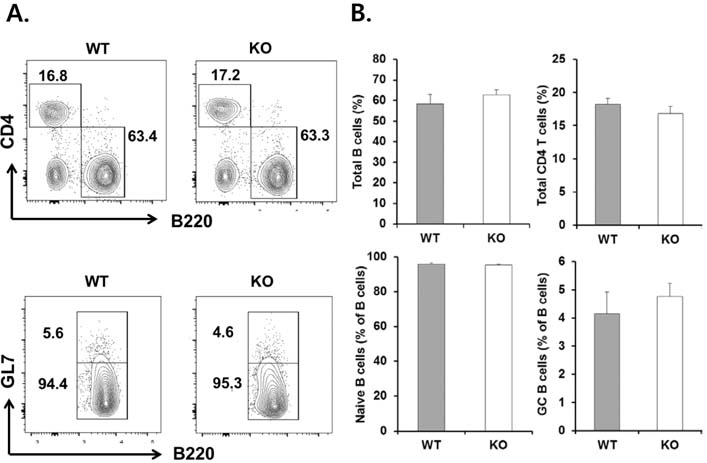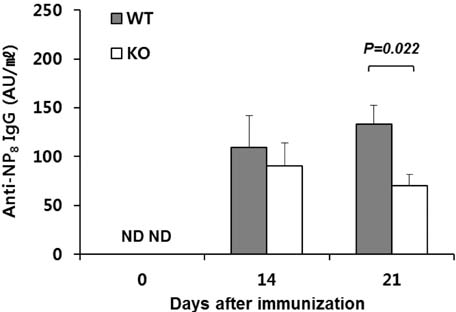Immune Netw.
2015 Jun;15(3):161-166. 10.4110/in.2015.15.3.161.
Early Growth Response-1 Plays a Non-redundant Role in the Differentiation of B Cells into Plasma Cells
- Affiliations
-
- 1Laboratory of Autoimmunology, Department of Anatomy and Cell Biology, College of Medicine, Hanyang University, Seoul 133-791, Korea. jhyoun@hanyang.ac.kr, paikdj@hanyang.ac.kr
- KMID: 2168042
- DOI: http://doi.org/10.4110/in.2015.15.3.161
Abstract
- Early growth response (Egr)-1 is a Cys2-His2-type zincfinger transcription factor. It has been shown to induce survival and proliferation of immature and mature B cells, respectively, but its role in the differentiation of B cells into plasma cells remains unclear. To examine the effects of Egr-1 deficiency on the activation of B cells, naive B cells from Egr1-/- mice and their wild-type (WT) littermates were activated to proliferate and differentiate, and then assayed by FACS. Proportions of cells undergoing proliferation and apoptosis did not differ between Egr1-/- and WT mice. However, Egr1-/- B cells gave rise to fewer plasma cells than WT B cells. Consistently, Egr1-/- mice produced significantly lower titer of antigen-specific IgG than their WT littermates upon immunization. Our results demonstrate that Egr-1 participates in the differentiation program of B cells into plasma cells, while it is dispensable for the proliferation and survival of mature B cells.
Keyword
MeSH Terms
Figure
Cited by 1 articles
-
Interleukin 17-expressing Innate Synovial Cells Drive K/Bxn Serum-induced Arthritis
Wang Shik Cho, Eunkyeong Jang, Ho-Youn Kim, Jeehee Youn
Immune Netw. 2016;16(6):366-372. doi: 10.4110/in.2016.16.6.366.
Reference
-
1. Tarlinton D, Radbruch A, Hiepe F, Dorner T. Plasma cell differentiation and survival. Curr Opin Immunol. 2008; 20:162–169.
Article2. Gomez-Martin D, Diaz-Zamudio M, Galindo-Campos M, Alcocer-Varela J. Early growth response transcription factors and the modulation of immune response: implications towards autoimmunity. Autoimmun Rev. 2010; 9:454–458.3. Adamson E, de Belle I, Mittal S, Wang Y, Hayakawa J, Korkmaz K, O'Hagan D, McClelland M, Mercola D. Egr1 signaling in prostate cancer. Cancer Biol Ther. 2003; 2:617–622.
Article4. Virolle T, Krones-Herzig A, Baron V, De Gregorio G, Adamson ED, Mercola D. Egr1 promotes growth and survival of prostate cancer cells. Identification of novel Egr1 target genes. J Biol Chem. 2003; 278:11802–11810.5. Adamson ED, Mercola D. Egr1 transcription factor: multiple roles in prostate tumor cell growth and survival. Tumour Biol. 2002; 23:93–102.
Article6. McMahon SB, Monroe JG. The role of early growth response gene 1 (egr-1) in regulation of the immune response. J Leukoc Biol. 1996; 60:159–166.
Article7. Dinkel A, Warnatz K, Ledermann B, Rolink A, Zipfel PF, Burki K, Eibel H. The transcription factor early growth response 1 (Egr-1) advances differentiation of pre-B and immature B cells. J Exp Med. 1998; 188:2215–2224.
Article8. Gururajan M, Simmons A, Dasu T, Spear BT, Calulot C, Robertson DA, Wiest DL, Monroe JG, Bondada S. Early growth response genes regulate B cell development, proliferation, and immune response. J Immunol. 2008; 181:4590–4602.
Article9. Seyfert VL, McMahon S, Glenn W, Cao XM, Sukhatme VP, Monroe JG. Egr-1 expression in surface Ig-mediated B cell activation. Kinetics and association with protein kinase C activation. J Immunol. 1990; 145:3647–3653.10. Ke J, Gururajan M, Kumar A, Simmons A, Turcios L, Chelvarajan RL, Cohen DM, Wiest DL, Monroe JG, Bondada S. The role of MAPKs in B cell receptor-induced down-regulation of Egr-1 in immature B lymphoma cells. J Biol Chem. 2006; 281:39806–39818.
Article11. Seyfert VL, McMahon SB, Glenn WD, Yellen AJ, Sukhatme VP, Cao XM, Monroe JG. Methylation of an immediate-early inducible gene as a mechanism for B cell tolerance induction. Science. 1990; 250:797–800.
Article12. Chen L, Wang S, Zhou Y, Wu X, Entin I, Epstein J, Yaccoby S, Xiong W, Barlogie B, Shaughnessy JD Jr, Zhan F. Identification of early growth response protein 1 (EGR-1) as a novel target for JUN-induced apoptosis in multiple myeloma. Blood. 2010; 115:61–70.
Article13. Jang E, Cho WS, Cho ML, Park HJ, Oh HJ, Kang SM, Paik DJ, Youn J. Foxp3+ regulatory T cells control humoral autoimmunity by suppressing the development of longlived plasma cells. J Immunol. 2011; 186:1546–1553.
Article14. Kim S, Park K, Choi J, Jang E, Paik DJ, Seong RH, Youn J. Foxp3+ regulatory T cells ensure B lymphopoiesis by inhibiting the granulopoietic activity of effector T cells in mouse bone marrow. Eur J Immunol. 2015; 45:167–179.
Article15. Segel GB, Woodlock TJ, Xu J, Li L, Felgar RE, Ryan DH, Lichtman MA, Wang N. Early gene activation in chronic leukemic B lymphocytes induced toward a plasma cell phenotype. Blood Cells Mol Dis. 2003; 30:277–287.
Article16. Mora-Lopez F, Pedreno-Horrillo N, Delgado-Perez L, Brieva JA, Campos-Caro A. Transcription of PRDM1, the master regulator for plasma cell differentiation, depends on an SP1/SP3/EGR-1 GC-box. Eur J Immunol. 2008; 38:2316–2324.
- Full Text Links
- Actions
-
Cited
- CITED
-
- Close
- Share
- Similar articles
-
- Hair follicle stem cells and mitochondria
- Autophagy Mediates Astrogenesis in Adult Hippocampal Neural Stem Cells
- Growth promotion of HepG2 hepatoma cells by antisense-mediated knockdown of glypican-3 is independent of insulin-like growth factor 2 signaling
- Hematopoietic Stem Cells Culture, Expansion and Differentiation: An Insight into Variable and Available Media
- Effects of Melatonin on MDPC-23 Cells Differentiation





